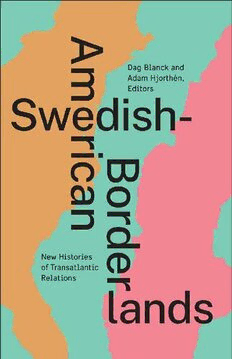
Swedish-American Borderlands: New Histories of Transatlantic Relations PDF
Preview Swedish-American Borderlands: New Histories of Transatlantic Relations
SWEDISH–A MERICAN BORDERLANDS This page intentionally left blank S W E D I S H –A M E R I C A N B O R D E R L A N D S NEW HISTORIES OF TRANSATLANTIC RELATIONS Dag Blanck and Adam Hjorthén, Editors UNIVERSITY OF MINNESOTA PRESS MINNEAPOLIS LONDON Copyright 2021 by the Regents of the University of Minnesota All rights reserved. No part of this publication may be reproduced, stored in a retrieval system, or transmitted, in any form or by any means, electronic, mechanical, photocopying, recording, or otherwise, without the prior written permission of the publisher. Published by the University of Minnesota Press 111 Third Avenue South, Suite 290 Minneapolis, MN 55401- 2520 http://www.upress.umn.edu isBn 978- 1- 5179- 0751- 8 (hc) isBn 978- 1- 5179- 0858- 4 (pb) Library of Congress record available at https://lccn.loc.gov/2021058758 Printed in the United States of America on acid- free paper The University of Minnesota is an equal- opportunity educator and employer. 28 27 26 25 24 23 22 21 10 9 8 7 6 5 4 3 2 1 Contents Acknowledgments ix Introduction: Conceptualizing Swedish– American Borderlands Dag Blanck and Adam Hjorthén 1 Part I. Across Waters and Lands 1. Reservation Borderlands: Gender and Scandinavian Land Taking on Native American Land Karen V. Hansen 45 2. Borderlands and Lived Encounters: The Swedish Immigrant, Interiority, and Home Philip J. Anderson 65 3. Imagining Borders and Heartland through Legend Jennifer Eastman Attebery 86 4. A Musical Borderland: How Jazz in Sweden Became Domesticated, 1920–1960 Ulf Jonas Björk 101 5. Ancestral Relations: The Twentieth- Century Making of Swedish- American Genealogy Adam Hjorthén 116 6. Academics on the Move: The Nature and Significance of a Swedish– American Intellectual Borderland Dag Blanck 135 7. The Role of Design in a Swedish– American Landscape Frida Rosenberg 154 Part II. Exchanges and Entanglements 8. Borderlands in Another World: How Sweden Envisioned New Sweden, circa 1638–1702 Charlotta Forss 177 9. Captain Jack’s Whip and Borderlands of Swedish– Indigenous Encounters Gunlög Fur 192 10. Double Life: American and Swedish Biographies of John Ericsson Thomas J. Brown and Svea Larson 211 11. Swedish- American Cookbooks: Linguistic Borderlands in Recipes Angela Hoffman and Merja Kytö 226 12. A Postwar Italian Kitchen Shining in the Swedish– American Borderlands Franco Minganti 243 13. Imaginary Borderlands: Ingmar Bergman’s and Michelangelo Antonioni’s Implicitly American Contact Zones Maaret Koskinen 258 14. Political Correctness in Sweden: A Borderland Conceptual History Magnus Ullén 277 15. History and Heritage in Bishop Hill, Illinois: Preservation, Representation, and Tourism in a Swedish– American Borderland Margaret E. Farrar and Adam Kaul 293 16. Negotiating the American Civil War: Memories and Gender in Swedish- American Civil War Reenactment Marie Bennedahl 310 Contributors 329 Index 333 This page intentionally left blank Acknowledgments This book is a collaborative effort and the result of work of a trans- atlantic academic community. We are first and foremost indebted to our authors for their dedication to this project during the past several years and for their willingness both to contribute their own research and to shape the ideas of the project as a whole. Our ideas about Swedish–A merican borderlands evolved through dis- cussions within an international and interdisciplinary network of schol- ars in the field of Swedish–A merican relations. Our meetings at Uppsala University in 2016 and at Sigtunastiftelsen in Sweden in 2017, where most of the authors participated, were particularly important. They were made possible through two research initiation grants from the Swedish Foundation for Humanities and Social Sciences. Beyond the authors in this volume, we also recognize the participation of Petter Bengtsson, Bo G. Ekelund, Lizette Gradén, Arne Lunde, Oskar Nordell, Linda H. Rugg, and Ann- Kristin Wallengren. The contributions to Swedish- American Borderlands: New Histories of Transatlantic Relations were significantly strengthened by scholars who read and commented on the chapters. Thank you to Jennifer Eastman Attebery, Anders Bergström, Ulf Jonas Björk, Anne Brædder, Ulla Böres- tam, Carl-H enrik Carlsson, Richard Evans, Ola Johansson, Anna Källén, Jim Leary, Helena Mattson, Magdalena Naum, Magnus Rodell, Ann-S ofie Rossholm, Jonathan Skinner, John Wilson, and David Östlund. Thank you to Harald Runblom for succinct feedback in the early stages of writing ix
